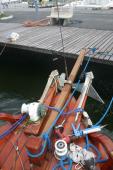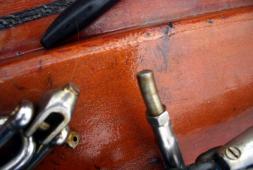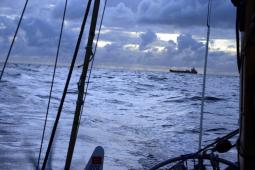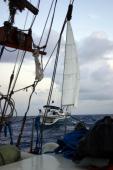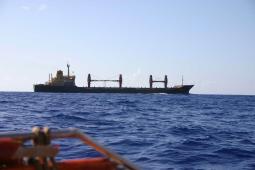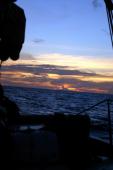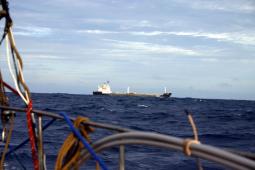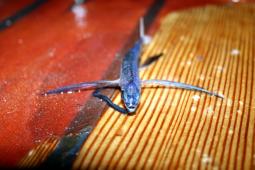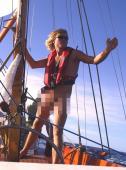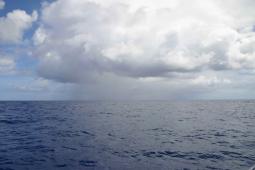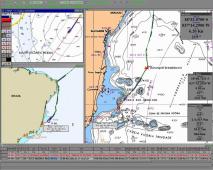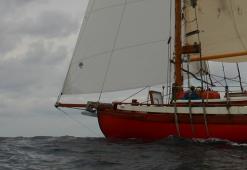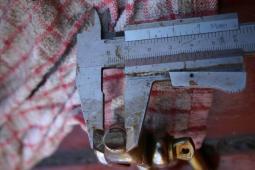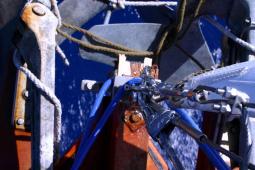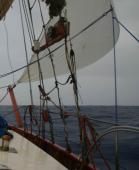Bowsprit brakedown
Av Staale
17 Februar 2004
Sted: Vitoria, Brazil, 300km NE of Rio De Janeiro. Message to norwegian reading people: This is written in english because it is also an explanation and a great thank to the people that helped me with weather information, tracking my position and support me when this accident occured.
20040212@1130Z Was Rozinante strucked by an squall. A squall is a word for a metrological situation that occurs when a piece of cold and heavy air forces its way into warmer air. The hot air rise and high gusts comes down from the clouds often combined with rain, poor visibilty and thunderstorms. This squall had gusts up to 45 knots and heavy rain. Squalls are very common in the tropical areas of any ocean in the world. They also occurs in non tropical areas but then they behave a little different. This was my third squall in 6 days so I'am getting used to them.
Before the squall I brought down the main sail and only the mizzen and the jib was up and running during the high gusts. After the squall the wind stopped as it often does, and there was heavy rainfall and almost no visibility. There is no point to be outside when you can't see shit and there is no wind. So I went inside and closed the hatch waiting for the rain to stop. Suddenly I heard a big crack from the direction of the bow. I grabbed my safetyline and opened the hatch and jumped out after a few seconds. The jib was up in the air and half of the bowsprit hanged on the bottom of the jib. The bowsprit was still connected to the boat with two of it's bowsprits shrouds. Since there was nearly no wind at the moment I didn't rush on and was very calm at that moment. My first intention was to take a picture of the occurence. I took down all the sails and started to work out the mess of wires, ropes, wood and sail.
The accident occured when a wire at tip of the bowsprit that is tensioned down to the bow at waterline level broked. I think it's called a waterstay. The wire did'nt broke but the turnbuckle broked. A pin that goes into the turnbuckle cracked. The pin had and diamter of 10 mm and was made of stainless steel. The reason it broked is probably beacuse of metal fatigue. When this wire isn't present. The bowsprit have no holding and the pressure on the bowsprit made by the jib bends it upward, and it cracked. I don't know exact what happened but one theory is that I hit something in the water or it may is an result of the squall but the bowsprit did'nt gave up at once. It's an quite normal failure on vessels with bowsprits.
I was 200 nm off the eastern coast of Brazil. I was half the way between Salvador and Vitoria. This distance of the brazilian coast have a lot of coral reefs and the pilot book says keep a wide berth of all the reefs if your not interessted in diving and snorkeling because this is one of the best areas in Brazil for this activity. I was not at all interessted in diving at the present time and found out that it was 270 nm to Salvador and 390 nm to Vitroia. The southern equatorial current comes from the east along the equataor and when it hits the brazilian coast at an latitude of 8 south (Recife) it divides and most of it goes north against the Caribbean. And the rest south. In summer (Des-Mar) it is strong and have a mean rate of 2 knots close to the shore. Strong NE winds may make it noticable as far as 200 nm offshore.
Salvador was not an option due to the navigational issues. It was also completly in the wrong direction of my plans. After a QSL on the HAM radio I got weather forecast with no strong southern winds between my postition and the only good port on the coast Vitroia. My new target was then Vitoria 390 nm to the SW of my present position.
To maintain some sailing. I couldn't bring up any sail with no forstay and a sailboat with no sails in big ocean waves is a rolling hell. The mast could in a worst case sceneraio crack if I put up any sails so I reduced the length on the forestay that is usualy assembeled at the end of the bowsprit with wireclamps and connected it at the bow where the second forstay are assembeled. When i tightened it the mast was stabilized again and I brought up the main and a foresail. But with no bowsprit the boat is no good sailor and I was also in an area with no good winds. I had to get to the closest port to fix the bowsprit.
The thing I didn't like was to run engine for three days. The first thing I did was to change the engine oil, checked the fresh water level, filled the grease lubricators and checked all hoses. But on the morning on Friday 13 I noticed that the engine temprature was more then above normal near water boiling point. I turned it off and found that a hose that goes from the cooling system on engine to the fresh hot water container to heat up the fresh water was leaking. This meant there was little fresh water in the cooling system. I looked in to my sparepart stock "department" of the boat and found a hose that matched but was to short so I bypassed the hotwater container. Filled up new fresh water on the engine and fired it up. It has worked since, but I have to get a new hose and replace the water with a mix of water and non freezing alcohol (glycol).
The thing you learn from this kind of small accidents are to have enough solutions in your head and have the necceserry items to fix things. There is always a plan to fix things, it's only the things you may need to fix it that isn't present out in the deep blue sea and you can't go to a workshop and buy the parts needed. When I was a kid I remember a childrens game called "My ship is loaded with..." If I ever be a kid again my favorite sentence in this game will be "My ship is loaded with spareparts!" I also know that if the bowsprit had broken very far away from land I probably could made a temporary one with one of the spread out boom for the forsails, but then I would have to cut it.
The same day I arrived Vitoria. Sunday I had a schedule monday morning with a local sailor and he made a deal with a guy building and repairing fishing boats to make a new bowsprit for me. Price: 50 US dollars for the best wood the nature can come up with. It will never brake again! While we where waiting for this guy to make the new bowsprit the local sailor took me to lunch in his house. He lived in a nice place and his wife had made some good food. After we had eaten we went to the airport to have a look at his helicopter. He's a helicopter pilot for a mining company and he brings clients out to the mines that are far away from any good roads. The helicopter was bulit in france/germany in 98 and was a new one. I learned some things about helicopters and air navigation this day. The bowsprit was finished three hours later.
One hour before dark, there was a coldfront coming in with a lot of lightning and rain. I checked the Internet and 24 hours after a cold front pass by the winds are mostly South and I decided to do not leave Tuesday and will leave Vitoria of Wednesday when the wind is stable from NE. In the evening I was invited to a barbeque with some sailors from the club. The party was in the biggest new house I ever been too. The house reminded me about houses that are used in the TV show Miami Vice with Don Johnson back in the early 80's. Here I got a lot of free drinks an free food and after 10 days at sea with little meat I ate a lot!
I will continue on to Santos on wednesday. To Santos it's between 500-600 nm and will take me 4-6 days. Depends on wind, traffic, and weather conditions. I will pass close to the biggest Oilfield in South America with about 100 oil rig installations.

